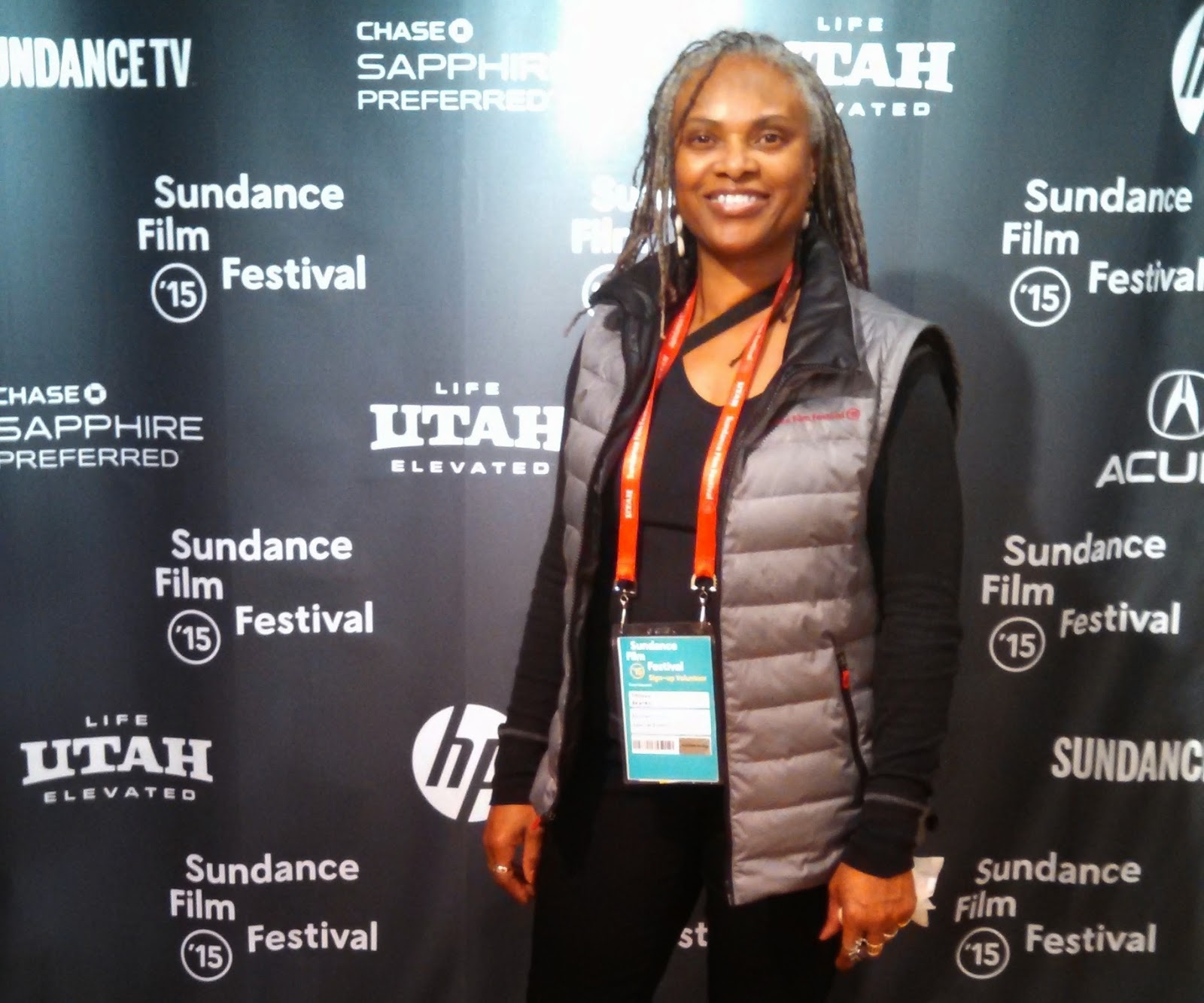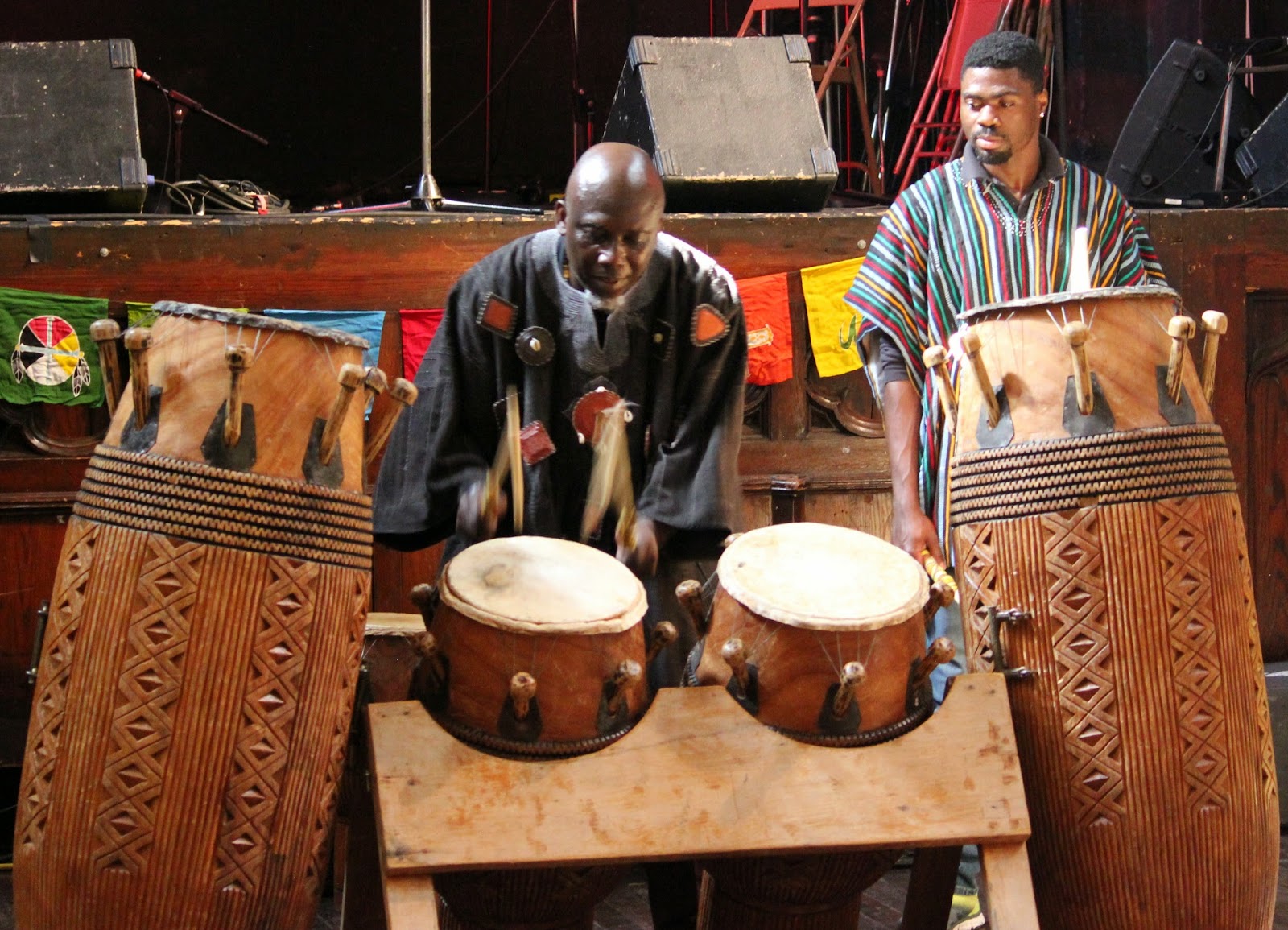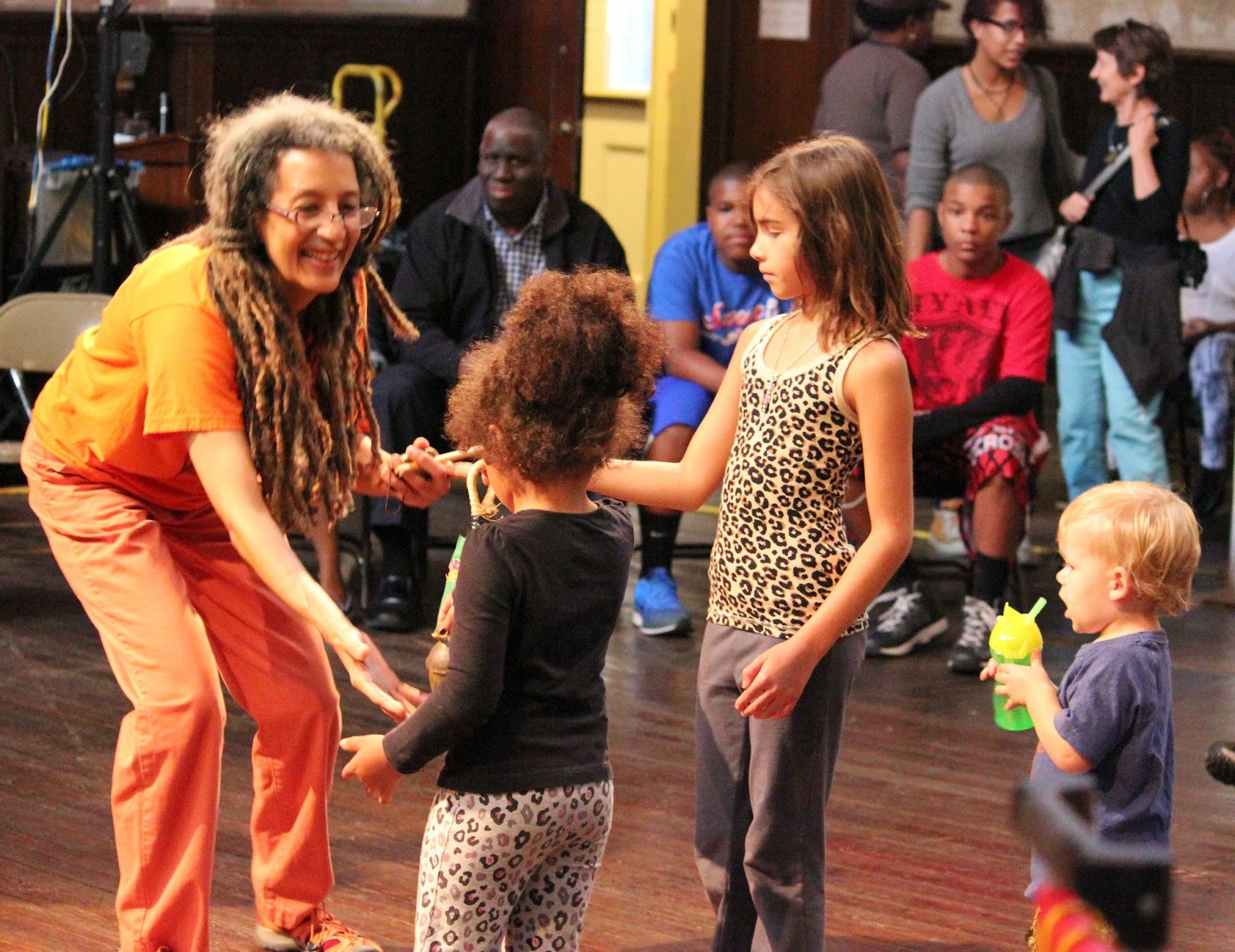
Titilayo Akanke standing in front of a banner at the Sundance Film Festival Co-op.
Working at the 2015 Sundance Film Festival was an exciting, valuable, and memorable experience. Approximately
1800 volunteers from around the globe assist with various aspects of festival
operations including serving as theatre crews, transportation assistants, staff
for special events, inventory signage personnel, crowd control assistants, and providing general and
logistical information. Volunteers have the option of working full time for the
duration of the festival; working half-time (half-fest) choosing either to work
the first or second week; or assuming a more flexible schedule and working a
minimum of twenty-four hours (sign-up volunteer) over a given period of time.
Festival benefits are awarded based on the number of hours worked. Full-time
volunteers work every day of the festival, but can see an unlimited number of
films during non-working hours. Half-fest volunteers work a minimum of forty
hours and receive a combination of full-time and sign-up benefits. Sign-up
volunteers receive a voucher for every four hours worked which are then
exchanged for theatre tickets. Working the festival allows volunteers to become
part of the Sundance family, to meet and network with people who share the love
of film, and to sit in the audience of film premieres.
As a sign-up
volunteer I was assigned the position, Special Events Assistant. For
five days of the ten day festival, I worked at several Park City, Utah venues
including the Legacy Lodge, The Shop, and the Festival Co-op. After picking up
my festival credentials and jacket, my first assignment was a 7:00 pm to
2:00 am shift at the Day One Party, the opening event for festival goers, at
the Legacy Lodge. Working with a team of volunteers, my tasks were to help set
up, work coat check, and clean up and remove decorations after the event. During
the course of the evening, several thousand guests attended this event which
appeared to be a successful welcome to Sundance 2015.
Below: Festival credentials
(bar code omitted).
Below: Festival credentials
(bar code omitted).
I worked two assignments
at another location called The Shop. The first event was a party for one of the
festival sponsors, Impact Partners. There, I worked an 8:00 pm to 1:00 am shift
and assisted with set-up and clean up; worked as a clicker counting attendees
as they entered and departed; served as a greeter and distributed complimentary
parting gifts to attendees; and was part of the coat-check team. On another day
at that location, as my third assignment from 1:30 pm to 6:00 pm, I worked an
event for the Utah Film Center (UFC) Brunch. At that event I primarily helped with set-up and clean up and with coat check. The two events in which I was
involved at The Shop both were in recognition of partners or affiliates of the
festival.
 |
| Festival uniform: silver jacket, black slacks or jeans, black or white top. |
At the Sundance Festival Co-op, I worked two different shifts: 9:30 am to 2:00 pm one day, and on another day from 1:30 pm to 6:00 pm. On both days my assignments were to act as greeter, floater, and to track attendance. I worked as a greeter in two different areas. The Sundance Festival Co-op was the location in which a number of corporate sponsors hosted interactive exhibits, showcased their products and/or services, and provided free samples to festival attendees. The managers of the venue also provided hot chocolate and hot apple cider for anyone entering the co-op.
Generously distributed and quite popular were the free yogurt provided by Chobani, free Luna Bars, and water bottles supplied by Acura. Popular also was the Acura interactive activity in which guests could drive a virtual car that was constructed around them. Participants then received a complimentary digital photograph of themselves in the cars. Guests also took advantage of the opportunity to take pictures in front of the Sundance Festival banner designed and placed specifically for that purpose. The festival co-op, open daily from 10:00 am to 6:00 pm, was bustling during the height of the festival as hundreds of people visited each day.

Photo by Titilayo Akanke

Photo by Titilayo Akanke
As a greeter at
the Sundance Festival Co-op entrance, I provided directions and information to
attendees as they entered, and checked credentials of the press, directors, and
producers to make sure only they were allowed in the area designated for them.
In the actual exhibit area of the co-op as people entered, I checked and
recorded badge information and directed people as needed. I also served as a
floater whose responsibility was to circulate throughout the venue and make
sure everyone (guests, volunteers, and sponsors) got the assistance or supplies
they needed. As floater, I also took pictures of guests in front of the
festival banner and filled in so volunteers could take breaks as required. At
the co-op treats were plentiful, exhibits and activities were festive, and
guests appeared to enjoy themselves immensely.
Some 3000
applicants applied for the 1800 volunteer positions available during the
Sundance Film Festival which substantially impacts the odds of being selected.
Although not expressively informed of the reasons I was chosen, my experience
as an intern at the Cannes Film Festival in France in 2011, four years as a
volunteer crew member for the Maryland Film Festival, and a background in
screenwriting likely played a role. Although many of the Sundance volunteers are
involved in the industry, a significant number of people are involved for other
reasons. Some work in other professions or are retirees, simply love film, and
volunteer as a hobby or special interest, vacation, travel opportunity, or
break from their daily lives.

Titilayo and another festival volunteer during a shift
at the festival venue, The Shop.
Sundance
administrators selected a diverse group of volunteers in terms of ethnicity,
age, and gender. Notably visible was the fact that at each of the venues to
which I was assigned, women were in charge. Lack of diversity in the film industry in the U.S. is a critical issue both in terms of stories that make it
to the big screen and those recognized as outstanding. Writing a story centered
on African-Americans or other ethnicities, or with a woman in the lead is still
considered a box office risk, and a script may be rejected in the mainstream
industry for those reasons. Producers of the Sundance Film Festival appear to
have tackled issues of bias and seem to be making an effort to be inclusive.
Working at film
festivals facilitates hand-on experience in the behind-the-scenes
operations, fosters an
opportunity to network, and provides chances to view films beyond those available
through mainstream sources. Alternative
and independent films frequently travel the film festival circuit before they
are released into theatres or on DVD. Storylines and documentary topics are
more likely to explore sociopolitical issues. At festival showings, producers,
directors, and cast members may be available for discussions after viewings.
Invaluable information about resources, production strategies, securing
financing, and casting are shared. Attending and working at film festivals is
comparable to attending a conference related to one’s career, political, or
social interest. The value is immeasurable and the benefits long-term.
Photo by Titilayo Akanke
Main Street in Park City at night. Photo by Titilayo Akanke
The view of the Wasatch Range, the western area of the majestic Rocky Mountains surrounding the Park City area is absolutely stunning. Skiers and snowboarders get on and off the bus toting their gear to and from the resort areas where they enjoy both sports. One local, in his forties, said he moved to the area so he could perfect his craft, and because he skis regularly he is in the best shape of his life. In describing the mountains, another local said they change color seasonally and take on completely different characteristics with each transformation.

The Wasatch Range near, the western area of the Rocky Mountains.
Photo by Titilayo Akanke
Photo by Titilayo Akanke
The Wasatch Range and homes at the foot of the mountains.
Photo by Titilayo Akanke
Photo by Titilayo Akanke
The Wasatch Range along Route 224 near Kimball Junction a few miles outside of Park City. Photo by Titilayo Akanke

Another view of the Wasatch Range along Route 224 on a cloudy day.
Photo by Titilayo Akanke
The Wasatch Range along Route 224. Photo by Titilayo Akanke
The Wasatch Range along Route 224. Photo by Titilayo Akanke
The Wasatch Range along Route 224. Photo by Titilayo Akanke
The African Diaspora Represented at 
Cronies, the thesis project of writer, director, Michael J. Larnell, tells the stories of three friends dealing with issues of friendship and loyalty, becoming mature young men while still seeking the thrills of partying and chasing women, and facing the consequences of their choices. The friendship of Louis (George Sample III) and Jack (Zurich Buckner) began when they were children and has been tested by tribulation in which they both suffered immensely. The newcomer, Andrew (Brian Kowalski), could be a threat to the duo or he could be just what is needed to establish a dynamic trio that will be an even stronger unit and provide a foundation for life long friendship between the three. In terms of cinematography, the film is shot in black and white and reflects the nuances of the blue-collar community in which it is shot.

Publicity photo featuring a scene from Cronies with
Zurich Buckner, George Sample III, and Brian Kowalski.
Larnell is a master of fine arts candidate at New York University in the Graduate Film Program, and a student of renowned writer, producer, director Spike Lee who teaches at the university. Larnell is also the recipient of a Dean's Fellowship and Kanbar Institute of Film and Television scholarship. Impressed with the depth of the story, Spike Lee joined the team as the executive producer in this first feature of Larnell's.

Talk-back with the cast after the showing of the film, Cronies. Left to right:
Brian Kowalski, Zurich Buckner, and George Sample III.
Photo by Titilayo Akanke.
Brian Kowalski, Zurich Buckner, and George Sample III.
Photo by Titilayo Akanke.

Two crew members and the cast of Cronies.
On the far right, writer, director, producer, Michael J. Larnell.
Photo by Titilayo Akanke.
The film, Fresh Dressed, chronicles the unique fashion that developed from the Hip-Hop movement from its beginning to the present. While the music addressed the concerns of urban life, the clothing supported the culture and ultimately influenced fashion around the globe. Directed by renowned filmmaker, writer, producer, and musician, Sacha Jenkins, the film is colorful, musically rich, and includes interviews with pioneers of the fashion and music industry as well as contemporary designers and artists. Fresh Dressed tells the story of how some fashion moguls gained long-term wealth and notoriety while others enjoyed only temporary success.
The film highlights the fact that the the Hip-Hop fashion industry was fueled by urban's youth's desire to cultivate an identity through the manner in which they dressed sometimes with the clothing on their backs as their most valuable asset. Questioned by an audience member about the film's failure to address the perpetuation of capitalism and young people's seeming preoccupation with the exterior trappings to affirm their being, Sacha responded that while he respected the person's analysis, his goal was to tell the story of the Hip-Hop fashion industry, not to provide a political analysis.
Publicity photo featuring a scene from the film, Fresh Dressed.
On stage during the talk-back after the film, Fresh Dressed,
director, Sacha Jenkins. Photo by Titilayo Akanke.
Sacha Jenkins is a native New Yorker who has chronicled the evolution of Hip-Hop culture since its inception. He is the recipient of a fellowship from Columbia University. He is the author of rapper Eminem's biography, The Way I Am, the producer of (The White) Rapper Show which airs on VH1, and was the music editor for Vibe magazine. Jenkins is involved in the production of the two magazines ego trip and Mass Appeal. He also works in partnership with the New York based media company, Mass Appeal.
Publicity photo (left to right), Chris Pine, Margot Robbie
and Chiwetel Ejiofor in a scene from Z for Zachariah
The film, Z for Zachariah depicts an apocalyptic scenario in which a young woman (actress Margot Robbie) struggles to maintain her farm untouched by radiation which appears to have destroyed most of the planet. When a scientist (actor Chiwetel Ejiofor) wearing a radiation proof contraption discovers her, the two establish a platonic friendship that will surely evolved into a passionate romance. That prospect is interrupted when yet another male stranger (actor Chris Pine) wonders onto the property. The competition for her affection ensues while the three develop plans for their continued survival. Human emotions reveal the best and worst in each and influence choices that impact their future. Written by Nissar Modi, Z for Zacharian is the third feature of director, Craig Zobel. His other works include Great World of Sound which premiered at the 2007 Sundance Film Festival, and Compliance which premiered at the 2012 Sundance Film Festival.

Publicity photo of singer Nina Simone
The Netflix documentary film, What Happened, Miss Simone, weaves archival footage, interviews, and performances to depict the life and struggles of songstress and Civil Rights activist, Nina Simone. Trained at first in classical music, Simone is best known for her soulful mix of jazz, blues, and folk music, and for lyrics that spoke to the African-American experience. The story explores her life as a child during the Jim Crow Era, her involvement in the Civil Rights Movement, her historical performance at Carnegie Hall, and her life abroad in Liberia and France. What Happened, Miss Simone is one of over 15 films produced by award winning documentary filmmaker and co-founder of Moxie Firecracker Films, Liz Garbus.
Publicity photo of Nina Simone. Property of Netflix/Moxie Firecracker Films

Publicity photo: The Black Panthers: Vanguards of the Revolution
Photo property of Firelight Media
The Black Panthers: Vanguards of the Revolution, is the eighth film of documentary filmmaker, Stanley Nelson to premiere at the Sundance Film Festival. The work includes archival footage and interviews with people from around the country who were involved in the movement that produced the revolutionary organization known as the Black Panther Party for Self Defense. Members, lawyers, police officers, journalists, former FBI agents, historians, and others provide testimony about the emergence and eventual decline of the legendary Black Panthers. In the fall of 2015, PBS Distribution will showcase the film in select theatres, and will broadcast it as part of the PBS series, Independent Lens in the winter of 2016.
Nelson maintains that "The Black Panthers made an indelible imprint on American culture and politics. The story of the rise and fall is essential history for understanding the times we live in, and the complicated political dynamics that are still at play."
Nelson's other films include Freedom Summer, Freedom Riders, Jonestown: The Life and Death of Peoples Temple, and The Murder of Emmett Till. He is the recipient of a MacArthur Genius Fellow, and the National Humanities Medal awarded to him in August 2014 by President Barack Obama. His company, Firelight Media, of which he is a co-founder, provides a Producers Lab for new filmmakers. Visit www.firelightmedia.tv for more information about the the upcoming distribution of Black Panthers: Vanguard of the Revolution.
Publicity photo of writer, producer, director Ousmane Sembene (right)
Photo property of Galle Ceddo Projects
Photo property of Galle Ceddo Projects
Directed by biographer Samba Gadjigo, and produced by Gadjigo and Jason Silverman, the film, Sembene! chronicles the life and work of legendary Senegalese filmmaker, Ousmane Sembene. The film includes archival footage and interviews with some of his closest friends and colleagues. Known as the father of African film, Sembene's work presents the culture, history, and sociopolitical issues affecting Africa in films such as Moolaade (2004) Faat Kine (2001) Guelwaar (1992), Camp Thiaroye (1988), Ceddo (1977) Xala, (1975) and Black Girl (1966).
Gadjigo, considered the foremost authority on Sembene's life and work, is also the director of the documentary, The Making of Moolaade, and the author of Sembene's biography, Ousmane Sembene: The Making of a Militant Artist (2010). An award winning producer and director, Silverman is the current cinematheque director of the Center for Contemporary Arts Santa Fe. He served as the director of the Taos Talking Picture Festival, and has produced events for the Smithsonian Institute, the Lensic Performing Arts Center (Santa Fe), the Tribeca Film Festival, and the Lannan Foundation.
For more information about black films from around the world, visit www.cinemaoftheafricandiaspora.com
Contact info: cinemaoftheafricandiaspora@gmail.com
Need a photographer?
Visit our website: www.imaginationvisualization.com
Contact us at imaginationvisualization@gmail.com

















































